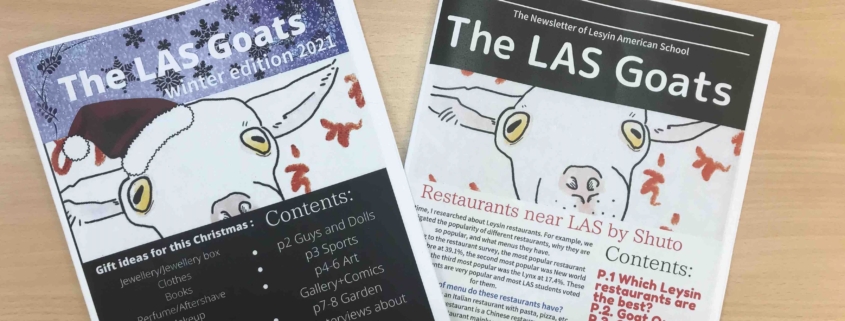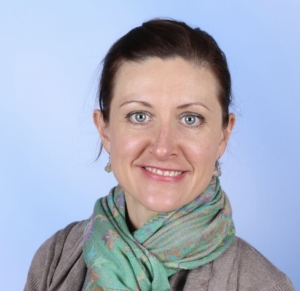Newsletter 101: A self-directed course for English Learners
Hatty Fryer Smith, Bilge Kalkavan, and Paul Magnuson
Veteran teacher, Hatty Fryer, is part of a group of teachers in an experimental program focusing first and foremost on transferable skills, e.g. collaboration and self-motivation. She creates room for students to practice these transferable skills by helping them create a school newsletter. The non-native English-speaking students are in US grades 8 through 10, with a range of language proficiency.
Hatty starts at the whiteboard, suggesting students break down their goals for the next newsletter into smaller steps to reach those goals. She asks her students to write these steps in bullet points using Google docs. Hatty leaves the board after a few minutes to speak with students individually about how they are planning to contribute to the next newsletter.
Bilge and Paul watch as Hatty speaks with the students. They notice the variety of topics the students are choosing to write about, from sports and video games to drug addiction and the LGBTQ+ community on campus. They also notice the numerous types of contributions students are planning: writing, interviewing, collecting art from students, collecting writing from students, talking to teachers in other classes, taking photos, and designing the pages.
This is an English writing course for non-native speakers, but in no way is the content limited to writing. Because the students are focused on an end product (with just a bit of the peer pressure that comes from publishing something for everyone else at the school), and because they have the freedom to determine both the end product and the work process themselves, the project does not seem contrived. Not only do they have to pull the newsletter together, they have to work on larger organizational issues, like balancing the complexity of the project with considerations for what is actually doable – and doable in what time frame. As students told us: Maybe we don’t have ideas so we have to think for ourselves, it’s hard to work by yourself without the teacher, and we have to find the things that we are going to do.
Their comments exemplify the goal of this class, and others like it in our Edge program’s set of elective courses. We are supporting student growth to greater self-agency. Along the way the students in this class are also very likely to improve their English writing skills.
Hatty had this to say:
Teaching an Edge class at Leysin American School (LAS) has caused me to examine my expectations and assumptions about students and learning in general. It brings into stark relief a point about learning that I, and perhaps other teachers, habitually lose sight of – namely, that the process is more valuable than the product.
In an Edge class, I am more conscious of myself than usual. I make an effort to step back and allow the students to get on with it because that’s the philosophy. When observing students I often think “Why would you do it that way when it would be so much better and quicker to do it this way?” It’s hard to resist that feeling after years of teaching students in a traditional way. But I have learned to keep quiet and to hope to be pleasantly surprised by the outcome.
About fifty percent of the time I am proud of the product. Typically, students work quite slowly without teacher assistance but do a fine job in the end.
The value of the process is clear: students are learning self-reliance. Sometimes the final product is great but completely different to what the student had talked about at the outset. In these cases learning is also clearly happening. When the teacher steps back, students have some space to discover what they are really interested in. Any interference from an authority, positive or negative, might stop them from changing tack and following their own instincts. Students learn to have self-confidence and to trust their own instincts and decision-making.
But I would say that about fifty percent of the students produce a final product that is disappointing. Do these students also benefit from the Edge class experience?
I haven’t yet experienced a student who didn’t submit any work at all, because although students are not graded and cannot fail, there is something about letting the group down that forces them to finish something, even if of poor quality and at the last minute. A common scenario, for example, is that a student starts a project with enthusiasm and then gets bored of it as the classes go on.
But I think that even if the student is not proud of their final product, they know that it is due to their own lack of work, making the process a valuable experience. Here is where my skills as a teacher are fully in play, because feedback to the student needs to be managed carefully. There must be a balance through helping the student learn through the experience of producing poor quality work so that the student sees the experience as a chance to learn rather than a failure. This is tricky since students have been trained most of their academic lives to avoid failure and they may be fighting feelings of shame or constructing all sorts of defense mechanisms.
If I as the teacher do not address what’s happened, they may withdraw (literally or figuratively) from the class – or they may decide that I really do not care if their final product is of poor quality. They will say they didn’t get the help they needed or that the course is ‘too easy’. But if they see that the teacher is non-judgemental and actually interested in ‘what went wrong’ – and genuinely not concerned about this particular final product – they will pick themselves up and try again.
Bilge and Paul leave the class to discuss the experience. Bilge noticed some of Hatty’s specific moves to keep the students in charge. To the student with an idea for the newsletter’s cover page, Hatty says: “Why don’t you ask the class if you can be the one to do the front page?” Hatty offered a strategy to move forward with the work – but didn’t use her status in the class to determine the course of the work. To the student who asked, “Miss, do we have to have the contents on the front page?” Hatty answered, “No. You do whatever you want.” It’s the process that counts, after all. Hatty’s approach gives important pedagogical insights for teaching contexts and reminds us to be facilitators for our students rather than a dominant teacher figure. From topic selection to design, Hatty allows her students to make their own decisions as autonomous learners. During teacher-student interaction, she hesitates imposing her opinion and assists them with her questions to help them to set their own goals and design their own work.
Paul smiled as he recounted what another student told him. “We don’t have to think about the grade. I think it’s super good. No grades is the best point [of the class]. It’s a workplace environment. You do it by yourself. If there’s a mistake … you can try something else. We can learn.”
Exactly. We can learn.
We would love to hear your thoughts – please share them below.
ABOUT THE AUTHORS
Hatty Fryer Smith graduated from university with a Masters in Contemporary Fiction and has taught EAL and English literature. Currently she teaches a Creative Writing class in which seven students from different nationalities and abilities in English come together three times a week to create a magazine for the school.
.
Bilge Kalkavan is in the Faculty of Education at Hasan Kalyoncu University. She has a PhD in Language and Communication, an MA in Applied Linguistics, and an MA in Business Administration. Her research interests include interaction studies, second language acquisition, language, culture, and communication. She visited Hatty’s class during her second stay at LAS as a visiting scholar.
.
Paul Magnuson is director of Educational Research at Leysin American School and Academic Development Specialist for Moreland University. He has a PhD in Curriculum & Instruction and an interest in furthering student agency.








Trackbacks & Pingbacks
[…] Source link […]
Leave a Reply
Want to join the discussion?Feel free to contribute!